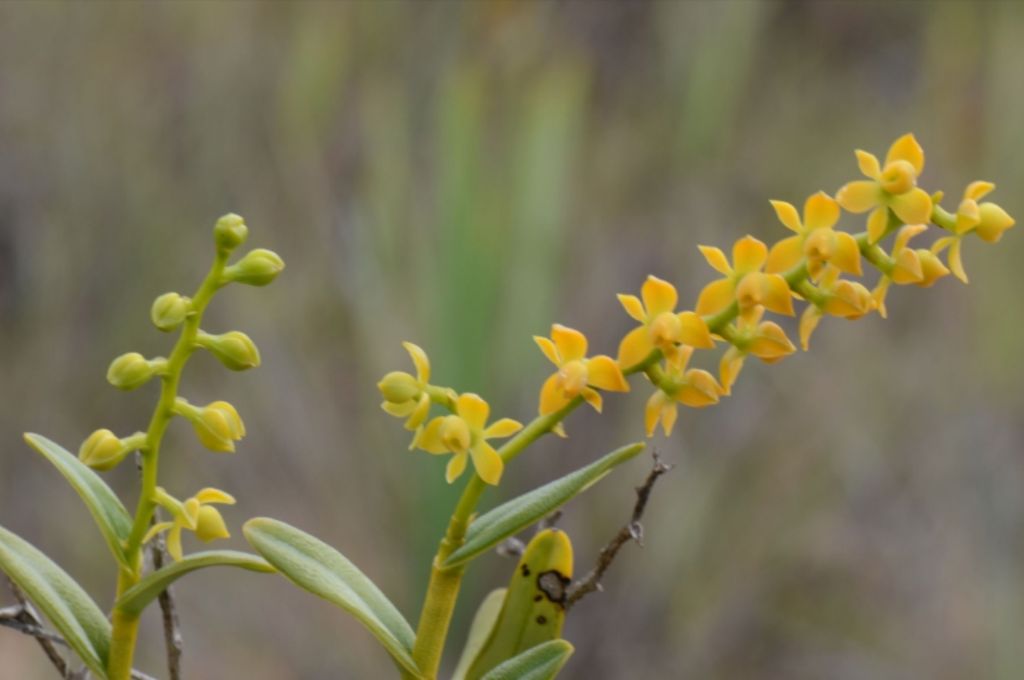

Epidendrum ulei Schltr.1914 GROUP Aquaticum
Photo by © Eric Hagsater/Drawing by R Jimenenz and The AMO Herbario Website
Photo by © Vladimir Dinets


 to
to
 to
to 
Common Name Ulei's Epidendrum [German Plant Collector in east and central Brazil later 1900's]
Flower Size .6" [1.5 cm]
Found in southern Venezuela, Guyana and northern Brazil on rocky outcrops, sandy or boggy soils at elevations of 1500 to 2500 meters as a medium to giant sized, cool to cold growing terrestrial or lithophyte with cane-like, branching, terete, erect, straight; primary stem longest, the branches much shorter, sub-apical, themselves branching stems carrying 20 on the primary stem, 5 to 7 on the branches, distributed along the apical 2/3 of the stems, articulate, distichous, fleshy-coriaceous, spreading, green above, grayish green on the underside; tubular, rugose, striated leaf sheaths, blade of the primary stem somewhat longer and the branches somewhat shorter, oblong, rounded, coriaceous, margin entire, revolute leaves that blooms in the spring and summer on a terminal, without a spathe, peduncle .28 to .36" [.7 to .9 cm]long, terete, thin; rachis straight, 1.8 to 2.8" [4.5 to 7.0 cm] long, 4 to 5.6" [10 to 14 cm] long overall on the main stem, 2.56 to 2.8" [6.4 to 7.0 cm] long overall on the branches, apical flowering only once, erect, paniculate, racemes recurved, laxly,simultaneously 15 to 50 flowered inflorescence with prominent, as long as the ovary to slightly longer, widely triangular, acute, rigid, forming a right angle with the rachis floral bracts and carrying small, nonresupinate, greenish yellow to ochre flowers without fragrance data.
"Epidendrum ulei belongs to the GROUP Aquaticum which is characterized by the monopodial, branching habit, the distichous, erect to arching-nutant inflorescence, with fleshy flowers, and the disc of the lip and/or nectary often pilose. The species is recognized by the erect, paniculate inflorescence 4 to 5.6" [10 to 14 cm] long, the racemes spreading, flowers greenish yellow to ochre, sepals .36 to .4" [9 to 10 mm] long, leaves oblong, apex rounded, 1 to 2.8" x .36 to .84" [2.5 to 7.0 x 0.9 to 2.1 cm], base of lip truncate, disc bicallose, the calli convergent. Vegetatively similar to Epidendrum alsum Ridl. but the inflorescence of the species is shorter, 1.2 to 2.6" [3 to 6.5 cm] long, arching-nutant, flowers yellow, sepals .32 to .36" [8 to 9 mm] long, leaves ovate, apex obtuse, slightly bilobed, 1 to 1.72" x .52 to .72" [2.5 to 4.3 x 1.4 to 1.8 cm], base of lip cuneate. Epidendrum carnosum Lindl. has an erect, generally paniculate inflorescence, the racemes all sub-parallel, flowers yellow, sepals .36 to .4" [9 to 10 mm] long, leaves lanceolate, apex acute, 1-6 to 3.46" x .24 to .52" [4 to 8.6 x 0.6 to 1.3 cm], base of lip cuneate, disc with a single callus. Epidendrum pseudavicula Kraenzl. has shorter inflorescences, 1.4 to 2.8" [3.5 to 7 cm] long, racemose, sometimes with a short branch, flowers are yellowish green, sepals 2.24 to 2.4" [5.6 to 6 mm] long, leaves narrowly ovate to oblong-lanceolate, apex rounded, base of the lip cuneate, disc bicallose the calli small, thin, parallel. Epidendrum durum Rchb.f. has racemose to paniculate inflorescences, flowers creamy white, smaller, sepals 2.6 to 2.8" [6.5 to 7 mm] long, leaves lanceolate to ovate-lanceolate, apex acute, .8 to 2.2" x .2 to .56" [2.0 to 5.5 x 0.5 to 1.4 cm] long." Hagsater etal 2018
Synonyms
References W3 Tropicos, Kew Monocot list , IPNI ; Repert. Spec. Nov. Regni Veg. Beih. 6: 73 Schlechter 1919; Venezuelan Orchids Illustrated Vol 6 Dunsterville & Garay 1976 as E dendrobioides drawing fide; Orchids of Venezuela; An Illustrated Field Guide Vol 1 Dunsterville & Garay 1979 as E dendrobioides drawing fide; Orchids of Venezuela [An illustrated field guide] Vol. 1 Ramiro and Carnevali 2000 drawing fide; Flora of the Venezuelan Guayana Vol 7 Steyermark, Berry, Yatskievych and Holst 2003 drawing fide; Icones Orchidacearum 16[1] Plate 1602 Hagsater & Santiago 2018 See recognition section; Icones Orchidacearum 16[1] Plate 1612 Hagsater & Santiago 2018 See recognition section; Icones Orchidacearum 16[1] Plate 1638 Hagsater 2018 See recognition section Icones Orchidacearum 16[1] Plate 1662 Hagsater & Sanchez 2018 See recognition section; Icones Orchidacearum 16[1] plate 1663 Hagsater & Santiago 2018 drawing/photo fide
--------------------------------------------------------------------------------------------------------------------------
-------------------------------------------------------------------------------------------------------------------